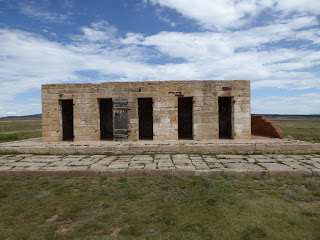Harry's is a great spot
After leaving the inn at 7:45 a.m., we had another terrific breakfast at Harry's Roadhouse, a breakfast-lunch-and-dinner place that seemed to be serving an equal number of locals and tourists. H had a well-stuffed breakfast burrito with green chile while I went with chilaquiles verde with over-medium fried eggs. Mmmmmmm!
Base elevation of 10,350 feet
Hiking was on the agenda for the day so we headed into the mountains, driving up to Ski Santa Fe through the Hyde Memorial State Park. A lot of the resort had been roped off for "filming" so we couldn't walk around much. Instead, we got our hiking stuff on and headed off into the Pecos Wilderness Area with a goal of Nambe Lake off the Winsor Trail. It was cool (51 F at 9:45 a.m., per my notes) and overcast but the rain held off until just after our 6.87 mile roundtrip hike, which was fortunate.
This is where it got steep
Here's a description of the trail: up, down, steep up, lake, steep down, up, down. The portion of the Winsor Trail we walked was broad and had pretty good footing, not too rocky, passing through pines, aspens and lichen-draped evergreens. Once we turned off the main trail towards the lake, it got very steep and very rocky for the duration, following the lake's outlet as it cascaded over the rocks.
Cloud ceiling was low at this point
The lake itself is fairly small, located in a steep-walled cirque. We heard (but did not see) pikas and marmots calling warnings at our approach; we heard (but did not see) other hikers above us on the ridge. Although there were lots of vehicles parked at the trailhead, we really didn't encounter many other folks, just fourteen hikers and three dogs, most as we were on our way back.
H by the lake
It was just starting to sprinkle as we downed our post-hike beers. That was encouragement enough to move on so we drove to the other side of the mountains to the Pecos National Historical Park to check out the ancestral ruins there. Unfortunately, it was just 45 minutes until closing so we rushed through it; although the entry to the park was free, there was a charge for the self-guided tour brochure, which we were unable to get because of some chatty retirees monopolizing the park ranger's time, so we didn't really have any information about what we were looking at. (We felt like we got the gist of it, however, having seen so many ruins already.)
Obligatory entrance sign photo
There are a couple of below-ground restored kivas that visitors are allowed to climb down into, so we could get a sense of just how dark it must have been in there. In addition to the ancestral Puebloan buildings, there are also Spanish ruins: the foundation of the first Franciscan church, built in 1621 and then destroyed in the Pueblo Revolt; and some of the walls of the second, constructed after the Reconquest (1692). Research at the park is ongoing as well: there was a group of twenty-somethings clearing brush from old walls and a scientist-type walking around taking measurements with a very fancy GPS system.
There are two fully excavated kivas on the grounds
but the others are mostly filled in, like this
When the park closed, we headed back to Santa Fe. The afternoon thunderstorms had really moved in at this point and by the time we got back to the room, it was downpouring. We waited out the weather and when the clouds had moved on, we went out to find dinner. My first thought was well-reviewed local favorite Tomasita's but when we got there, it was packed full with at least fifty people waiting ahead of us (you couldn't even get into the bar).
The remains of the second grand church at Pecos NHP
Undaunted, we continued into the trendy Railyard area and ended up at the Second Street Brewery. A couple seats at the bar later, we were happily downing IPAs and English milds, a green chile stuffed burger, green chile chicken stews and street-style tacos. It was an eclectic mix of folks in the joint, made perhaps even moreso because it was the Geeks Who Drink-sponsored trivia night. We stayed long enough to hear the first three rounds of play, then headed home in the light rain.
Second Street Brewery, Railyard location
























































